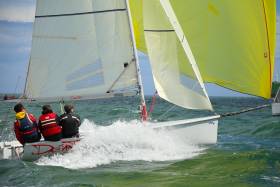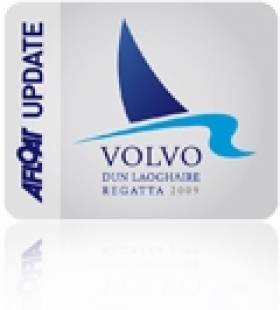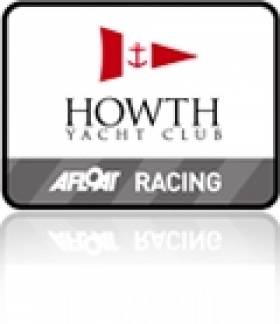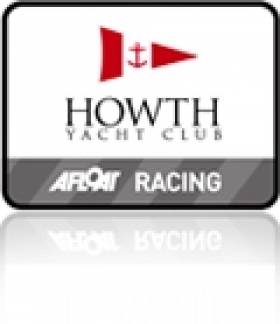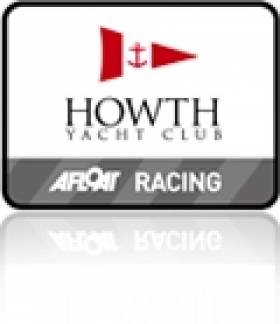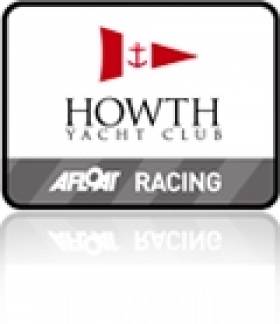Displaying items by tag: Howth YC
SB20s Line Up 2017 Fixtures, Mayo Yacht Club To Host Westerns
An exciting 2017 Championship schedule includes old favourites Howth YC and Royal Ulster YC as well as a return trip to Mayo YC.
This year's World Championships will be held in Royal Yacht Squadron, Cowes making it highly accessible from Ireland.
2017
21st – 22nd April Eastern Championships Howth Yacht Club, Dublin
26th – 27th May Northern Championship Royal Ulster Yacht Club, Bangor
16th – 17th June Western Championship Mayo Yacht Club, Mayo
06th – 09th July Southern Championship Royal St. George Yacht Club, Dun Laoghaire (as part of Volvo DL Regatta)
26th – 1st Aug World Championships Royal Yacht Squadron, Cowes, UK
15th – 17th Sept National Championships Howth Yacht Club, Dublin
21st – 22nd Oct Midland Championships Lough Derg Yacht Club, Tipperary
#irishsailing – After five years of economic contraction, there are signs of recovery, and the 2014 Irish sailing season has also got off to a flying start. W M Nixon looks at various signs of new energy and initiatives, and sees how they might be affecting stories which have been run on this blog and in the Afloat.ie website during the past year. But he concedes that further cost reductions will be necessary for the good of the sport.
A year ago, any talk of green shoots in Ireland was almost entirely metaphorical. And it was in the economic sphere, though even there they were still few and far between, with many soon stunted. But out in the farmers' fields themselves, out where the grass should have been growing, there was scarcely a sign of life as we were still trapped in the coldest and most miserable Spring in living memory, and all forms of growth and recovery were blighted by it.
Sailing and boating, of all sports, are the most affected by Ireland's climatic conditions. Not only is the mood among participants strongly influenced by weather which sometimes can get anyone down, but without reasonable breezes, sailing events are seriously impaired. "We got a result!" may well be the PRO's final desperate claim after pulling some sort of a points table and leaderboard out of a series bedevilled either by too much or too little wind. But it's so much better to have a series bathed in sunshine and blessed by fine breezes, with enough races sailed for the crews to go home tired but happy without needing recourse to any of those weasel words which show you're only trying to justify a weekend of frustration.
Things could not be more different this year. The Spring of 2014 has been perfection, boats are going afloat on time and in reasonable weather conditions, and the first little crop of events and results are very encouraging indeed - so encouraging, in fact, that "little crop" doesn't do them justice.
That said, two of the nearer events which gave special cause for Irish celebration did not have perfect weather throughout. The Youth Sailing Nationals at Howth may have ended on a high with a great breeze in an early taste of summer sunshine, but one day out of the four was lost to bad weather. But the sting of that was lessened by the decision for "no racing all day" being taken at 1100hrs, which allows other leisure options to kick in.
The IRC Easter Championship in the Solent concluded through Easter Monday literally with "Darkness at Noon" – the heavy clouds and torrential rain on an almost windless day saw the final races being sailed with nav lights on. But there had been excellent racing on earlier days, and a very excellent result with Anthony O'Leary's Ker 39 Antix from Cork the clear supreme champion.
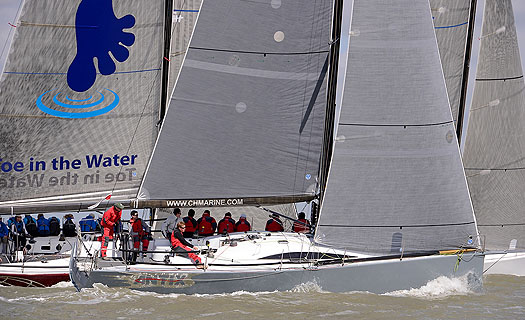
Doing the business. Anthony O'Leary's Ker 39 Antix settling into the groove on the way to the top place in the Easter IRC Championship. Photo: Rick Tomlinson
That in turn augured well for Ireland's Commodore's Cup chances, which then received a further boost last weekend when the crew of another Irish team wannabe, Quokka with Michael Boyd and Niall Dowling, had a winning weekend in the Warsash series with their temporary mount Tarka in anticipation of Quokka's return from the Caribbean at the end of May.

The Colours Match team racing between UCD and Trinity served up top sport in the Liffey, with Trinity winning. Photo: W M Nixon
Meanwhile the universities racing has been brought to life, for although UCD had a convincing win in the racing with the SailFleet J/80s to become the Irish team for the Student Yachting Worlds in France in the Autumn, before April was out the Colours Match in the Liffey under the burgee of the Royal Alfed YC, team-raced in Fireflies, saw Trinity take the honours in convincing style.
But if we're looking for something which really did set things freshly alight, it was out in Hyeres where the ISAF Championship saw the northern duo of Ryan Seaton & Matt McGovern take silver in the 49er, almost immediately moving them up the global rankings from 33 to 11, a quantum leap and no mistake.
The potential for serious success by these two has been fairly obvious for some time, but anyone who sails boats will know only too well how many factors have to come into alignment to get you up among the magic metals at the end of the day.

Stars of the silver sea – the Seaton/McGovern team took a silver medal for Ireland at Hyeres.
That their new global status was almost immediately acknowledged by this rankings improvement will in turn add heft to everything they do and say. Thus when, some time ago, the Ryan/Seaton equipe suggested that the 2016 Olympics sailing waters in Brazil are so off the standard as to be a health hazard, it attracted polite attention. But now that they're Number 11, and still counting down, much more notice is taken. And the fact that the Vice President of the International Olympic Committee has suggested, with something approaching despair, that the facilities in Brazil just aren't going to be ready for 2016 at any standard, all gives added legs to the statement from Ireland's 49er crew.
This in turn makes us wonder where world sailing might go in 2016 if the Brazilian setup is still Work in Progress. With tongue only slightly in cheek, we suggest they need look no further than West Cork, where Baltimore Sailing Club has been expanding its facilities to meet increased demand as a club which last year introduced something like 700 people to sailing. That BSC and current Mitsubishi Motors "Club of the Year" Kinsale YC further east along the West Cork coast have both been putting in premises up-grade during the past year, while other clubs have been having it tough, and just about hanging in there in some cases, surely gives pause for thought.
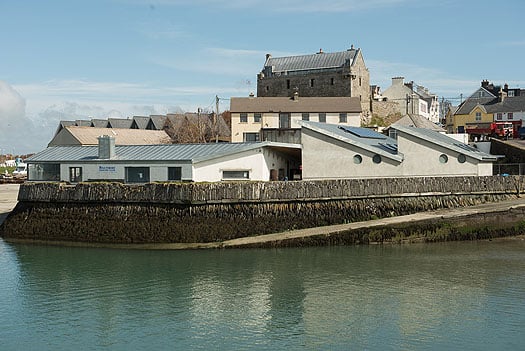
Olympic venue? The extended and up-graded Baltimore Sailing Club is ready and raring to go.
The economic shakeout of the past five years has caused a massive write-down in the value of almost all property and other assets. And in the case of yacht and sailing clubs, there has been a detailed examination of the continuing validity, or otherwise, of established yacht clubs and their traditional business model of quite high subscriptions under-writing other facilities which in turn combine to provide the complete package of an orthodox yacht club.
Inevitably, most clubs are run by officers and committee members who have been involved with the club for many years. Thus, like people who have been running a quality hotel for decades, they may have an inflated notion of what their organisation and its premises are actually worth. Admittedly there's only limited usefulness in comparing a yacht club with a hotel, but lessons can surely be learned. The fact is that hotels today are worth maybe only a third or even less of what they were reckoned to be worth six years ago. And equally, while yachts clubs certainly have a unique package to offer, is it unusual enough and special enough to charge high subscriptions when there are alternative facilities and services available?
The dilemma arises to some extent in all sailing centres. Last week we were discussing the story of the development of Howth YC. Today it is in the seemingly happy situation of having its own marina, thus it theoretically can offer an attractive all-in-one package to any potential member. But the very fact that Howth YC has done so much to help make Howth a colourful and vibrant sailing/fishing port is partly to its own disadvantage. The place has developed as a remarkable focus for top seafood restaurants. This means that the extensive club catering facilities – expected by traditional members - are constantly battling for business with a whole slew of award-winning eateries and characterful pubs nearby.
The problem is more acute in Dun Laoghaire in that the only club within the marina area is the Royal Irish YC. Thus while people may have been loyal members of the National, the Royal St George and the Dun Laoghaire Motor Yacht Club, they find that after going out in the boat, it's very easy to round out the evening aboard in the marina, chatting among themselves or with other crews on boats nearby, and then head straight for home without making their number in their home clubs at all.
This situation is less in evidence at weekends and during special events. But nevertheless it was causing such a lessening in mid-week club vitality that various steps have been taken, and the Royal St George's move to take over berths in a block booking in the outer marina, and service them by a frequent ferry direct from the clubhouse, is a visionary step.
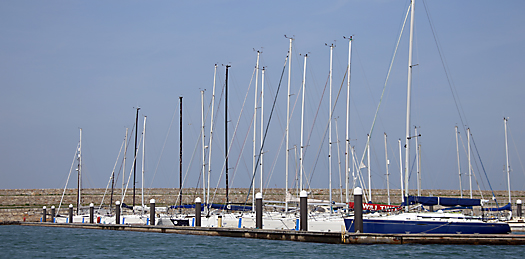
The Royal St George YC has introduced a direct ferry service from the clubhouse to its group of berths in the outer marina in Dun Laoghaire. Photo: David O'Brien
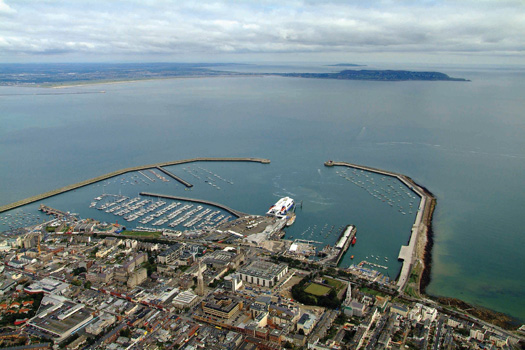
To overcome a lack of direct access to the Dun Laoghaire Marina, the Royal St George YC is running a ferry service from its clubhouse (to right of Stena Ferry, foreground) to the berths in the Outer Marina (upper left) Photo Kevin Dwyer/courtesy ICC.
Nevertheless, in all club administrations there are those who are of the opinion that, whatever the Honorary Treasurers may believe, there has to be a radical re-think of the primary subscription levels. In essence, they're suggesting that the book value of the club has to be written down such that subscriptions are halved. Personally, I haven't much of a notion of how to read a balance sheet, but the dogs in the street know that in the hospitality industry – which, in the broadest sense, is the area in which yacht and sailing clubs operate – values have been savagely slashed, and while charges may still seem high, at least the places are surviving as going concerns.
With continuing reduction in expenses across the board, one area in which there seems to be much work afoot is in the Irish Sailing Association, which in latter days had begun to seem like some hidden corner of the civil service, existing more for the benefit of staff than for the provision of services for sailors. It's amazing to learn that the ISA has sixteen fulltime staff, and a basic annual wages bill of something like €600,000. When you add in the expected benefits, it musty come in total to a very tidy yearly sum.
What on earth do they all do? While you'll invariably find the ISA logo in prominence at some top events, it has to be said that you're entirely unaware of the organisation's existence in any form at more everyday happenings, and it doesn't seem to be because they believe in doing good work by stealth. But with special study groups resulting from the major changes introduced in the ISA setup at the AGM in March, we can only hope that in time the Association will reflect the cost-cutting which has had to be introduced in the clubs, which provide the main part of the ISA's income.
While the administrative structures are rightfully being pared back in many areas of our sport, the coastal infrastructure, on which all forms of seagoing ultimately depend, continues to need maintenance and development. In this area, one very promising green shoot is the news that there are signs of movement in Dunmore East. A dredging programme is getting under way, and just this Tuesday, Minister for Marine Simon Coveney TD convened a meeting in the port to inaugurate a community approach to harbour development which, it is hoped, will help to invigorate the many places around Waterford Estuary, for which Dunmore East has the potential to be the true gateway harbour.

Dunmore East – can it fulfil its potential as the gateway leisure port for the Waterford Estuary? Photo Kevin Dwyer, courtesy ICC
In a more extreme marine environment, it has been confirmed that €6 million will be spent on improving the pier at Doolin in northwest Clare, the nearest mainland quay to the Aran Islands, which also caters for the tour boats cruising along the Cliffs of Moher. While the locals seem well pleased, I wouldn't get too excited about it. This is one very rugged part of the coast, and when you remember that it took €31 million to extend the pier at Kilronan in Inismor, the main Aran island, and another €14 million to build the little harbour at the north end of Inis Meain, the middle Aran island, then we can only hope that €6 million is going to achieve something more than a few boulders being shifted about in the roaring ocean at Doolin.

The pier at Doolin is decidedly minimalist, but it provides the shortest sea passage to the Aran Islands. Photo: W M Nixon
But then, in the west all things are possible, and along the ocean seaboard we're told that four thousand signs are being erected to guide people along the Wild Atlantic Way, the new tourism initiative using many smaller coastal roads. Quite so. Frankly, with signage at this level, it will be the Tame Atlantic Way by the time half of them are in place. I have to admit to being a complete curmudgeon in this. In many years of transitting Ireland's west coast by sea and land, one of our favourite areas while driving along the west coast has long been the coast south of Kilkee down to Loop Head, where the cliffs comfortably rival anything the vulgar Cliffs of Moher have to offer, and it is magnificently uncrowded. But not any more, if the Wild Atlantic Way movement has its way.
While I appreciate that visitor numbers have to be kept up and increased whenever and however, it has to be done in a way which appreciates that's what brings people to Ireland (rather than just to Dublin, which is a special case) is an unspoilt landscape. So, four thousand signs just for the one Atlantic Way? Ogden Nash had something to say about this:
"I think that I shall never see,
A billboard lovely as a tree.
But then, until the billboards fall,
I'll never see a tree at all".
Be that as it may, the final sign that suggests things are on the move again is a notice I spotted recently posted at a nearby club, though language pedants might wonder how a notice which manages to mangle so utterly the plural of "dinghy", even to adding a completely superfluous greengrocer's apostrophe, could be seen as encouraging in any way whatsoever.
Well, once you've overcome your opinions about the errors, the underlying message must be good news. More youngsters are evidently coming to sailing this year. And as for the spelling mistake, even that's an improvement. A year ago, the same notice board opened by referring to something called "a dingy", but this time round we have to get to the second line before finding that. And it all comes right for dinghies in the end.
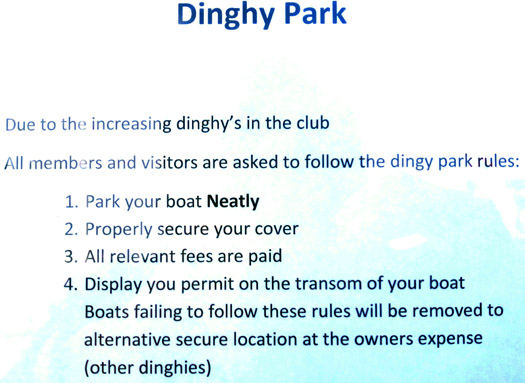
Sign of the times? Whatever about the spelling, this current notice at an Irish sailing club has an underlying message of good news. Photo: W M Nixon
Howth Yacht Club's Crazy Horse is T-Boned in Home Water
#vdlr2013 – Competitors from Dublin's Northside got some wry satisfaction in yesterday's racing in the Volvo Dun Laoghaire Regatta when several classes were brought north round the Baily to avail of the superior racing waters between Ireland's Eye and Lambay writes WM Nixon.There, well out of Dublin Bay's flukey breezes and nine clear miles north of the Dun Laoghaire pierheads, they found perfect sailing conditions with southeast breezes building to 15 knots as the day made on.
So in this happy fleet, how could you tell the top Northside boats from the Southside visitors? Easy, really. They T-bone each other, just when the going is at its best. It's as simple as that.
In the second race, beating out past the Stack on the northeast corner of Ireland's Eye with a fine beat in prospect with the ebb all the way back to Dun Laoghaire, ICRA Commodore Nobby Reilly on the Mills 36 Crazy Horse (co-owned with Alan Chambers), was powering along on starboard, revelling in his own home waters off Howth. Things were looking good, the racing was great, condition were perfect, and Crazy Horse was contending for overall leader in Class 0 with a first in Thursday's race in Dublin Bay, and a fourth in Friday morning's race off the Fingal coast.
When things seem to good to be true, they usually are. Another Northside star - Pat Kelly's top J/109 Storm from Rush - came sweeping in on port, and was too late in taking avoiding action. She T-boned Crazy Horse on the port side, taking out the stanchions and guardrails, and inflicting enough hull damage to mark the end of the Horse's regatta.
Thankfully, no-one was injured, though it was too close for comfort for Crazy Horses's cockpit crew. But the shock for all involved will take some recovery. Our commiserations to everyone caught up in this crash.
Multiple Champions Sign Up for Howth's BMW J/24 Worlds
#hyc – The current World Champion Mauricio Santa Cruz of Brazil, 2011 European Champion Ian Southworth of Britain and the top two finishers in this year's North American Championship are among the leading names already entered for the BMW J/24 World Championships at Howth Yacht Club in late August. Almost 40 entries have been received to date from nine countries.
Santa Cruz, a four-time winner of the title, was so keen to defend his title that he was the first overseas entry in the competition. He also won the Worlds in 2006, 2007 and 2009.
Ian Southworth from the Royal Corinthian YC in Cowes is already familiar with Howth, having won the J/24 Europeans there two years ago, and he completed a hat-trick of those titles in 2007.
Leading the US challenge will be this year's North American Champion Mike Ingham and runner-up Travis Odenbach, both from Rochester, NY, while among the leading Irish contenders will be the current National Champion JP McCaldin from Lough Erne and Irish Class President Flor O'Driscoll of the host club.
Luis Olcese from Peru and Japanese entry Koji Matsumoto represent highly competitive challenges as both are recognised as notable performers in J/24 circles and have finished well at previous championships.
The Worlds racing programme, preceded by three days of registration and measurement, starts on Monday 26th August and continues until Friday 30th.
Howth Yacht Club (HYC) Racing Results for 18th June
17 Scr
1,Echo,B & H Lynch
2,Isobel,B & C Turvey
3,Aura,I Malcolm
17 Hcap
,Echo,B & H Lynch
2,Isobel,B & C Turvey
3,Aura,I Malcolm
Squib Scr
1,Kerfuffle,J Craig & H Ruane
2,Selik,F O'Kelly
3,Chatterbox,J Kay
Squib Hcap
,Kerfuffle,J Craig & H Ruane
2,Selik,F O'Kelly
3,Chatterbox,J Kay
Howth Yacht Club (HYC) Results for Wed, 12th June 2013
Class 3 IRC
1,Hard on Port,F O'Driscoll
2,Kilcullen Euro Car Parks,HYC K25 Team
3,Starlet,Bourke/Others
Class 3 HPH
1,Starlet,Bourke/Others
2,Stage Fright,Wormald/Walsh
3,Helly Hunter,L McMurtry
White Sail IRC
1,Bite the Bullet,C Bermingham
2,Jokers Wild,G Knaggs
3,Brazen Hussy,Barry/Stirling
White Sail HPH
1,Jokers Wild,G Knaggs
2,Brazen Hussy,Barry/Stirling
3,Bite the Bullet,C Bermingham
J24 Yacht Wins Howth's Lambay Race (Results Here!)
#lambayrace – Rarely have Lambay race competitors at Howth Yacht Club crossed the start and finish lines wearing shorts! The 2013 Lambay Races were bathed from start to finish in glorious sunshine and a light north-easterly breeze. Over 120 boats competed and boat of the day was "Hard on Port", a J24 which showed a clean pair of heels to some other Class 3 yachts winning by 3:20 minutes.
Scroll down for Lambay Race Results below
In his report on the event, HYC's Emmet Dalton says winning skipper Flor O'Driscoll put his success down to skirting closely along the southern shore off Lambay and getting into some slack tidal patches.
Regular Howth Yacht Club competitors were joined by sailors from other clubs, swelling the numbers to over 120 boats.
The Howth Seventeens, the class that kicked off the Lambay Races over a century ago, were lead home by Ian Malcolm's "Aura". Suitably, that class was awarded its prizes first.
A "GoPro" camera, ideal for recording the good and bad parts of any sailing venture, was raffled and won by Squib sailor, Serena Blacoe. The full proceeds of the raffle, over €400 go to Howth Lifeboat
Howth Yacht Club Results for Lambay Races Saturday 8th June
Class 1 IRC
1,Crazy Horse,Chambers/Reilly,HYC
2,Storm,P Kelly,HYC
Class 1 ECHO
1,Crazy Horse,Chambers/Reilly,HYC
2,Storm,P Kelly,HYC
Class 2 IRC
1,Dux,A Gore-Grimes,HYC
2,King One,D Cullen,HYC
3,Impetuous,Noonan/Chambers,HYC
Class 2 ECHO
1,Dux,A Gore-Grimes,HYC
2,Rosie,R Dickson,MYC
2,Impetuous,Noonan/Chambers,HYC
Class 3 IRC
1,Hard on Port,F O'Driscoll,HYC
2,CriCri,P Colton,RIYC
3,Jebus,E Dalton,HYC
Class 3 ECHO
1,CriCri,P Colton,RIYC
2,Buster,P Higginbotham,MYC
3,Hard on Port,F O'Driscoll,HYC
White Sails A - IRC
1,Bite the Bullet,C Bermingham,HYC
2,Flashback,Hogg/Breen,HYC
3,White Lotus,P Tully,DLM
White Sails A - ECHO
1,Cogar,K & C Halpin,HYC
2,White Lotus,P Tully,DLM
3,Changeling,K Jameson,HYC
White Sails A - HPH
1,Cogar,K & C Halpin,HYC
2,Bite the Bullet,C Bermingham,HYC
3,Indulgence,D Sargent,HYC
White Sails B - IRC
1,Demelza,Ennis/Lauden,HYC
2,Jokers Wild,G Knaggs,HYC
3,Out & About,McCoy/Cregan,HYC
White Sails B - ECHO
1,Demelza,Ennis/Lauden,HYC
2,Jokers Wild,G Knaggs,HYC
3,Lolly Folly,C & L Phelan,HYC
White Sails B - HPH
1,Lolly Folly,C & L Phelan,HYC
2,Demelza,Ennis/Lauden,HYC
3,Wayfinder,J Reynolds,HYC
Shipman Scratch
1,The Den,S Miller,RStGYC
2,White Rock,H Robinson,RIYC
3,Macro One,J Murray,RIYC
Ruffian 23 Scratch
1,Paramour,Larry Power,NYC
2,Ruffles,M Cutliffe,DMYC
3,Diane 2,A Claffey,RStGYC
Puppeteer Scratch
1,Eclipse,A & R Hegarty,
2,Harlequin,Clarke/Egan,
3,Cloud 9,C Feeley,
Puppeteer Hcap
1,Cloud 9,C Feeley,
2,Eclipse,A&R Hegarty,
3,Ghosty Ned,Donal Harkin,
Squib Scratch
1,Seabiscuit,G Blacoe,
2,Black Amour,Sean O'Reilly,
Squib Hcap
1,Seabiscuit,G Blacoe,
2,Black Amour,Sean O'Reilly,
17 Footer Scratch
1,Aura,I Malcolm,
2,Rita,Curley/Lynch,
3,Oona,Peter Courtney,
17 Footer Hcap
1,Aura,I Malcolm,
2,Rita,Curley/Lynch,
3,Echo,B & H Lynch,
J80 Scratch
1,Jamie Carton
2,P Watson
3,Laura Dillon
More on the Howth Yacht Club site here
Class 2 IRC
1 Dux A Gore-Grimes
2 King One D Cullen
3 Toughnut D Skehan
Class 2 HPH
1 Dux A Gore-Grimes
2 Toughnut D Skehan
3 King One D Cullen
Class 3 IRC
1 Hard on Port F O'Driscoll
2 Jebus E Dalton
3 Starlet Bourke/Others
Class 3 HPH
1 Starlet Bourke/Others
2 Turtle R Hogg
3 Jebus E Dalton
White Sail IRC
1 Bite the Bullet C Bermingham
2 Alphida H Byrne
3 Sandpiper of Howth A Knowles
White Sail HPH
1 Sandpiper of Howth A Knowles
2 Empress III FitzPatrick/Glennon
3 Alphida H Byrne
#matchracing – The Champion vs the Pretender. The King vs the Prince. On paper the match between Peter Baylys Team Top Gun (Peter Bayly, Richie Murphy, Ian McNamee and Paddy Blackley) and Graham Barkers Whitefire Racing (Graham Barker, Ryan Scott, Sam O'Byrne, Luke Malcolm and Shane Diviney) looked to be a matchup between the nouse of Bayly for the champions and the exuberance of Ryan Scott at the helm of the challenger. The better prepared Whitefire Racings chance was to take it to the Bayly from the off, while the longer the match went on the more the champions would begin to find their groove.
In practice giving up 45kg in crew weight in the brisk 17-20kt open water conditions in Howth left the champions without their predicted ace and the sharper boat handling of Whitefire and prestart of Scott prevailed 3-0.
That Team Top Gun haven't match raced competitively since winning the title as the Royal St George Gladiators in 2011, whereas Scott and the DUC Sailing Team that made up Whitefire Racings crew, have been active for the last 18 months became immediately apparent. In race one Top Gun took a soft port/starboard penalty during circling in the prestart and, although given opportunity to pull away at the top of the first beat, never managed to open enough of a gap to take their turn before the finish loomed.
The second race began with Top Gun opting for the favoured pin end but seeding the power of the right. When Bayly chose to tack and duck before the layline and Scott took the opportunity to slam dunk the extra power and weight of the Whitefire Racing crew became apparent. Despite the entire crew hanging off sheets and bottle screws Top Gun couldn't get any bow forward and the challengers took control of the series 2-0.
A failed attempt to cross in prestart left Scott with a penalty and with a better round up off the start and power of the right the fight back from the Champion looked to be on. But as the breeze picked up to 20kts the challenges upwind advantage told and they managed take the starboard approach at the windward mark and lead the race, extending far enough by the finish to clear their penalty.
In the end a 3-0 win for Barker fairly reflected the difference between the crews with small advantages in all areas adding up to make Whitefire Racing the new Irish National Match Racing Champions.
The event gave rise to discussion on holding regular Friday night match racing at HYC. More news on that as we have it.
Howth Yacht Club (HYC) Results for Wednesday, May 22nd
#HYC – Results from HYC club racing on Wednesday, 22nd May 2013.
Class 2 IRC
1,8094,King One,D Cullen
2,1411,Toughnut,D Skehan
3,7495,Maximus,P Kyne
Class 2 HPH
1,7495,Maximus,P Kyne
2,1411,Toughnut,D Skehan
3,8094,King One,D Cullen
Class 3 IRC
1,4794,Hard on Port,F O'Driscoll
2,680,Kilcullen Euro Car Parks,HYC K25 Team
3,8188,Alliance II,V Gaffney
Class 3 HPH
1,5470,Lee na Mara,O'Malley/Keegan
2,218,Turtle,R Hogg
3,4794,Hard on Port,F O'Driscoll
White Sail IRC
1,3335,Bite the Bullet,C Bermingham
2,37050,Sandpiper of Howth,A Knowles
White Sail HPH
1,1343,Arcturus,P & D McCabe
2,37050,Sandpiper of Howth,A Knowles
3,3335,Bite the Bullet,C Bermingham



























